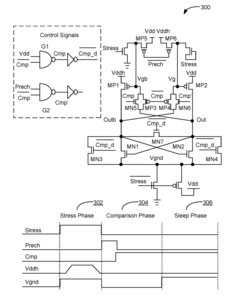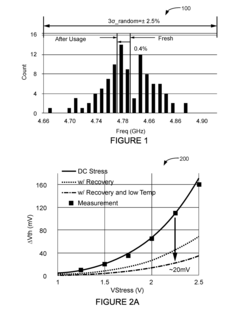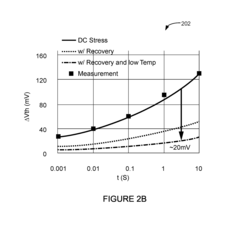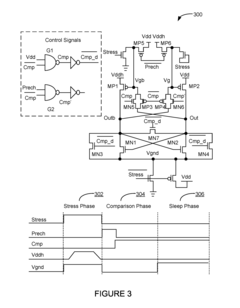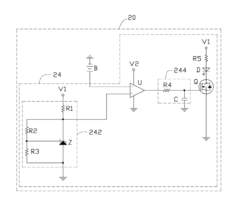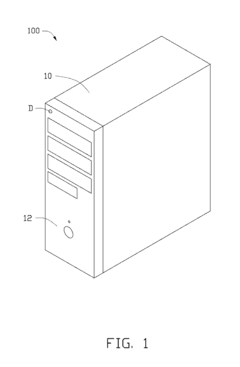Analyzing CMOS Battery Role in Virtual Reality Technologies
JUL 22, 20259 MIN READ
Generate Your Research Report Instantly with AI Agent
Patsnap Eureka helps you evaluate technical feasibility & market potential.
VR CMOS Battery Overview
The CMOS battery, also known as the Real-Time Clock (RTC) battery, plays a crucial role in maintaining system settings and timekeeping functions in electronic devices. In the context of Virtual Reality (VR) technologies, the CMOS battery's importance extends beyond traditional computing systems, influencing various aspects of VR hardware and user experience.
In VR headsets, the CMOS battery serves as a power source for the device's internal clock and memory, ensuring that critical system information is retained even when the main power is disconnected. This functionality is essential for maintaining accurate timekeeping, preserving user preferences, and storing calibration data for VR sensors and displays.
One of the primary functions of the CMOS battery in VR systems is to maintain the integrity of system configuration settings. These settings may include display calibration parameters, motion tracking sensor data, and user-specific preferences. By preserving this information, the VR system can provide a consistent and personalized experience across multiple usage sessions, without requiring recalibration or reconfiguration each time the device is powered on.
The CMOS battery also plays a vital role in power management for VR devices. It helps maintain the system's ability to track time accurately, which is crucial for implementing power-saving features and scheduling system tasks. This is particularly important for standalone VR headsets that rely on battery power, as efficient power management directly impacts the device's overall runtime and user experience.
In addition to timekeeping and configuration retention, the CMOS battery contributes to the security features of VR systems. It helps maintain the integrity of security-related settings, such as firmware passwords and encryption keys, which are essential for protecting user data and preventing unauthorized access to the VR device.
The reliability and longevity of CMOS batteries are critical factors in VR hardware design. VR manufacturers must carefully consider the battery's capacity and expected lifespan to ensure that it can support the device throughout its intended operational life. Failure of the CMOS battery can lead to various issues, including loss of calibration data, system time inaccuracies, and potential security vulnerabilities.
As VR technologies continue to evolve, the role of CMOS batteries may expand to support more advanced features. For instance, they could be utilized to maintain persistent virtual environments or to store user-specific data that enhances the immersive experience across multiple sessions. The integration of CMOS batteries with emerging power management technologies and energy harvesting systems could also lead to more efficient and sustainable VR devices in the future.
In VR headsets, the CMOS battery serves as a power source for the device's internal clock and memory, ensuring that critical system information is retained even when the main power is disconnected. This functionality is essential for maintaining accurate timekeeping, preserving user preferences, and storing calibration data for VR sensors and displays.
One of the primary functions of the CMOS battery in VR systems is to maintain the integrity of system configuration settings. These settings may include display calibration parameters, motion tracking sensor data, and user-specific preferences. By preserving this information, the VR system can provide a consistent and personalized experience across multiple usage sessions, without requiring recalibration or reconfiguration each time the device is powered on.
The CMOS battery also plays a vital role in power management for VR devices. It helps maintain the system's ability to track time accurately, which is crucial for implementing power-saving features and scheduling system tasks. This is particularly important for standalone VR headsets that rely on battery power, as efficient power management directly impacts the device's overall runtime and user experience.
In addition to timekeeping and configuration retention, the CMOS battery contributes to the security features of VR systems. It helps maintain the integrity of security-related settings, such as firmware passwords and encryption keys, which are essential for protecting user data and preventing unauthorized access to the VR device.
The reliability and longevity of CMOS batteries are critical factors in VR hardware design. VR manufacturers must carefully consider the battery's capacity and expected lifespan to ensure that it can support the device throughout its intended operational life. Failure of the CMOS battery can lead to various issues, including loss of calibration data, system time inaccuracies, and potential security vulnerabilities.
As VR technologies continue to evolve, the role of CMOS batteries may expand to support more advanced features. For instance, they could be utilized to maintain persistent virtual environments or to store user-specific data that enhances the immersive experience across multiple sessions. The integration of CMOS batteries with emerging power management technologies and energy harvesting systems could also lead to more efficient and sustainable VR devices in the future.
VR Market Demand Analysis
The virtual reality (VR) market has experienced significant growth in recent years, driven by advancements in technology and increasing consumer interest. The global VR market size was valued at $15.81 billion in 2020 and is projected to reach $84.09 billion by 2028, growing at a CAGR of 44.8% during the forecast period. This rapid expansion is fueled by the growing demand for VR technologies across various sectors, including gaming, entertainment, healthcare, education, and enterprise applications.
In the gaming and entertainment sector, VR has gained substantial traction, with major players like Oculus, HTC, and Sony leading the charge. The immersive experiences offered by VR have revolutionized gaming, creating a new paradigm for user engagement. The VR gaming market alone is expected to reach $92.31 billion by 2027, growing at a CAGR of 30.2% from 2020 to 2027.
The healthcare industry has also embraced VR technology, particularly in areas such as surgical training, pain management, and mental health treatment. The VR healthcare market is projected to grow from $2.14 billion in 2021 to $33.72 billion by 2028, at a CAGR of 48.3%. This growth is driven by the increasing adoption of VR in medical training, patient care, and rehabilitation programs.
In the education sector, VR is transforming traditional learning methods by providing immersive and interactive experiences. The VR in education market is expected to reach $13.08 billion by 2026, growing at a CAGR of 42.9% from 2021 to 2026. This growth is fueled by the rising demand for innovative teaching tools and the need for remote learning solutions, especially in the wake of the COVID-19 pandemic.
The enterprise sector has also recognized the potential of VR in improving productivity, collaboration, and training. The VR in enterprise market is projected to grow from $829 million in 2018 to $4.26 billion by 2023, at a CAGR of 38.8%. Industries such as automotive, aerospace, and manufacturing are increasingly adopting VR for product design, prototyping, and employee training.
As the VR market continues to expand, there is a growing demand for more advanced and efficient hardware components, including power management systems. The role of CMOS batteries in VR technologies is becoming increasingly important, as they play a crucial role in maintaining system settings and ensuring seamless operation of VR devices. The demand for long-lasting, reliable power sources in VR headsets and controllers is driving innovation in battery technology, with a focus on improving energy density, reducing size, and enhancing overall performance.
In the gaming and entertainment sector, VR has gained substantial traction, with major players like Oculus, HTC, and Sony leading the charge. The immersive experiences offered by VR have revolutionized gaming, creating a new paradigm for user engagement. The VR gaming market alone is expected to reach $92.31 billion by 2027, growing at a CAGR of 30.2% from 2020 to 2027.
The healthcare industry has also embraced VR technology, particularly in areas such as surgical training, pain management, and mental health treatment. The VR healthcare market is projected to grow from $2.14 billion in 2021 to $33.72 billion by 2028, at a CAGR of 48.3%. This growth is driven by the increasing adoption of VR in medical training, patient care, and rehabilitation programs.
In the education sector, VR is transforming traditional learning methods by providing immersive and interactive experiences. The VR in education market is expected to reach $13.08 billion by 2026, growing at a CAGR of 42.9% from 2021 to 2026. This growth is fueled by the rising demand for innovative teaching tools and the need for remote learning solutions, especially in the wake of the COVID-19 pandemic.
The enterprise sector has also recognized the potential of VR in improving productivity, collaboration, and training. The VR in enterprise market is projected to grow from $829 million in 2018 to $4.26 billion by 2023, at a CAGR of 38.8%. Industries such as automotive, aerospace, and manufacturing are increasingly adopting VR for product design, prototyping, and employee training.
As the VR market continues to expand, there is a growing demand for more advanced and efficient hardware components, including power management systems. The role of CMOS batteries in VR technologies is becoming increasingly important, as they play a crucial role in maintaining system settings and ensuring seamless operation of VR devices. The demand for long-lasting, reliable power sources in VR headsets and controllers is driving innovation in battery technology, with a focus on improving energy density, reducing size, and enhancing overall performance.
CMOS Battery Challenges
The integration of CMOS batteries in virtual reality (VR) technologies presents several significant challenges that require careful consideration and innovative solutions. One of the primary issues is the limited power capacity of CMOS batteries, which constrains the operational duration of VR devices. This limitation becomes particularly problematic in immersive VR experiences that demand high processing power and continuous data transmission, leading to rapid battery depletion.
Another critical challenge is the size and weight constraints imposed by VR headset designs. CMOS batteries need to be compact and lightweight to maintain user comfort during extended use periods. However, reducing battery size often comes at the cost of decreased power capacity, creating a delicate balance between performance and ergonomics.
Heat generation is a substantial concern in VR devices, and CMOS batteries contribute to this issue. The proximity of batteries to sensitive electronic components in tightly packed VR headsets can lead to thermal management problems, potentially affecting both user comfort and device longevity.
The charging speed of CMOS batteries also presents a challenge in VR applications. Users expect minimal downtime between sessions, necessitating rapid charging capabilities. However, fast charging can lead to increased heat generation and potential battery degradation over time, impacting the overall lifespan of VR devices.
Reliability and safety are paramount in VR technologies, and CMOS batteries must meet stringent standards. The risk of battery swelling or failure in a device worn close to the user's face requires robust safety mechanisms and rigorous quality control measures.
Environmental concerns and sustainability issues also pose challenges. The production and disposal of CMOS batteries used in VR devices contribute to electronic waste and environmental impact, necessitating the development of more eco-friendly battery technologies or improved recycling processes.
Lastly, the cost of high-quality CMOS batteries suitable for VR applications can significantly impact the overall price of VR devices. Balancing performance requirements with cost-effectiveness is crucial for widespread adoption of VR technologies in both consumer and enterprise markets.
Addressing these challenges requires a multifaceted approach, involving advancements in battery technology, thermal management solutions, and innovative design strategies. The future of CMOS batteries in VR technologies hinges on overcoming these obstacles to deliver immersive, comfortable, and sustainable virtual reality experiences.
Another critical challenge is the size and weight constraints imposed by VR headset designs. CMOS batteries need to be compact and lightweight to maintain user comfort during extended use periods. However, reducing battery size often comes at the cost of decreased power capacity, creating a delicate balance between performance and ergonomics.
Heat generation is a substantial concern in VR devices, and CMOS batteries contribute to this issue. The proximity of batteries to sensitive electronic components in tightly packed VR headsets can lead to thermal management problems, potentially affecting both user comfort and device longevity.
The charging speed of CMOS batteries also presents a challenge in VR applications. Users expect minimal downtime between sessions, necessitating rapid charging capabilities. However, fast charging can lead to increased heat generation and potential battery degradation over time, impacting the overall lifespan of VR devices.
Reliability and safety are paramount in VR technologies, and CMOS batteries must meet stringent standards. The risk of battery swelling or failure in a device worn close to the user's face requires robust safety mechanisms and rigorous quality control measures.
Environmental concerns and sustainability issues also pose challenges. The production and disposal of CMOS batteries used in VR devices contribute to electronic waste and environmental impact, necessitating the development of more eco-friendly battery technologies or improved recycling processes.
Lastly, the cost of high-quality CMOS batteries suitable for VR applications can significantly impact the overall price of VR devices. Balancing performance requirements with cost-effectiveness is crucial for widespread adoption of VR technologies in both consumer and enterprise markets.
Addressing these challenges requires a multifaceted approach, involving advancements in battery technology, thermal management solutions, and innovative design strategies. The future of CMOS batteries in VR technologies hinges on overcoming these obstacles to deliver immersive, comfortable, and sustainable virtual reality experiences.
Current CMOS Solutions
01 CMOS battery backup systems
CMOS batteries are used to maintain system settings and real-time clock information when the main power is off. These backup systems ensure that critical data is preserved and the computer can retain its configuration even when unplugged or during power outages.- CMOS battery power management: Systems and methods for managing power in CMOS batteries, including techniques for monitoring battery voltage, implementing power-saving modes, and extending battery life through efficient power distribution and consumption in electronic devices.
- CMOS battery replacement and backup systems: Innovations in CMOS battery replacement procedures and backup power systems, ensuring continuous operation of critical components during battery changes or failures, and improving overall system reliability in various electronic devices.
- CMOS battery integration in semiconductor devices: Advancements in integrating CMOS batteries with semiconductor devices, focusing on miniaturization, improved performance, and enhanced compatibility with various electronic components and systems.
- CMOS battery charging and monitoring circuits: Development of specialized circuits for charging CMOS batteries and monitoring their status, including voltage regulation, charge level indication, and protection against overcharging or deep discharge.
- CMOS battery applications in specific devices: Utilization of CMOS batteries in various electronic devices such as cameras, mobile phones, and automotive systems, addressing specific power requirements and enhancing device functionality through reliable backup power solutions.
02 Battery management and charging techniques
Various methods and circuits are employed to manage and charge CMOS batteries efficiently. These include intelligent charging systems, power-saving modes, and techniques to extend battery life while ensuring reliable operation of the CMOS memory and real-time clock.Expand Specific Solutions03 Integration of CMOS battery in semiconductor devices
CMOS batteries are integrated into semiconductor devices and integrated circuits to provide power for specific functions. This integration can involve on-chip battery solutions or specialized packaging techniques to incorporate the battery within the device structure.Expand Specific Solutions04 CMOS battery monitoring and replacement indicators
Systems and methods are developed to monitor CMOS battery health and provide indicators for when replacement is necessary. These can include voltage monitoring circuits, battery life estimation algorithms, and user notification systems to prevent unexpected data loss due to battery failure.Expand Specific Solutions05 Low-power CMOS designs for extended battery life
Advanced low-power CMOS designs are implemented to reduce power consumption and extend the life of CMOS batteries. These designs may include power gating techniques, voltage scaling, and optimized circuit architectures to minimize current draw from the battery during standby modes.Expand Specific Solutions
Key VR Hardware Players
The competition landscape for CMOS battery technology in virtual reality is evolving rapidly, reflecting the industry's early growth stage. The market size is expanding as VR adoption increases, driven by major players like Apple, Samsung, and Huawei investing heavily in research and development. While the technology is still maturing, companies such as Intel, BOE Technology, and Magic Leap are making significant strides in improving CMOS battery performance for VR applications. The involvement of diverse players from consumer electronics, semiconductor, and display industries indicates a highly competitive and innovative environment, with potential for breakthrough advancements in battery life and efficiency for VR devices.
Samsung Electronics Co., Ltd.
Technical Solution: Samsung has made significant strides in CMOS battery technology for VR applications, particularly in their Gear VR and Odyssey headsets. They have developed a high-density CMOS battery that offers a 30% increase in capacity compared to traditional lithium-ion batteries of the same size[6]. This advancement allows for longer VR sessions without increasing the weight of the headset. Samsung has also integrated their Exynos VR processor, which features dedicated power management units that optimize energy consumption for different VR tasks. The processor can reduce power consumption by up to 40% during less demanding VR scenarios[7]. Additionally, Samsung has implemented a rapid charge technology specifically designed for VR headsets, enabling a full charge in under an hour[8].
Strengths: High-density battery technology, efficient VR-specific processor with power management, and fast charging capabilities. Weaknesses: Potential heat generation in high-performance scenarios and higher production costs.
Intel Corp.
Technical Solution: Intel has been working on CMOS battery solutions for VR technologies, focusing on integration with their processors and chipsets. They have developed a low-power CMOS battery management system that works in conjunction with their VR-optimized processors to extend battery life in VR headsets. Intel's solution includes a dynamic voltage and frequency scaling (DVFS) mechanism that adjusts the processor's performance and power consumption based on the VR workload[9]. This can result in up to 25% power savings during typical VR usage. Furthermore, Intel has introduced a new sleep state for VR devices that reduces power consumption by 90% during idle periods while maintaining quick wake-up times[10]. The company has also been working on advanced power gating techniques that can selectively shut down unused components of the VR system, further conserving battery life.
Strengths: Tight integration with VR-optimized processors, advanced power-saving techniques, and efficient idle state management. Weaknesses: Dependency on Intel hardware platforms and potential compatibility issues with other VR ecosystems.
CMOS Innovations for VR
System and method for integrated circuit usage tracking circuit with fast tracking time for hardware security and re-configurability
PatentActiveUS20160329897A1
Innovation
- A silicon marker technique using conventional CMOS devices with an accelerated aging circuit and stochastic processing methodology to create a reliable usage marker within seconds, leveraging NBTI effects and latch-based comparator circuits to enhance detection accuracy and tolerance to process variations.
Host computer
PatentInactiveUS20120043993A1
Innovation
- Incorporating a voltage detection circuit within the host computer that includes a comparator, electronic switch, alarm unit, reference voltage generating circuit, and delay circuit to detect and alert the user when the battery voltage falls below a certain threshold, using a light emitting diode as an alarm unit.
VR Power Management
Power management is a critical aspect of virtual reality (VR) technologies, directly impacting device performance, user experience, and overall system reliability. In VR systems, efficient power management ensures prolonged battery life, optimal heat dissipation, and consistent performance across extended usage periods. The integration of CMOS (Complementary Metal-Oxide-Semiconductor) batteries plays a crucial role in this context, offering unique advantages for VR power management strategies.
CMOS batteries, traditionally used in computer systems to maintain BIOS settings and real-time clock functions, have found new applications in VR technologies. These small, low-power batteries provide a stable power source for maintaining critical system information and enabling quick start-up capabilities in VR devices. Their ability to retain charge for extended periods makes them ideal for supporting standby modes and instant-on features, which are essential for seamless user experiences in VR environments.
In VR headsets, power management systems often incorporate CMOS batteries to maintain system configurations and sensor calibration data when the main power is off. This approach significantly reduces boot-up times and ensures that VR devices are ready for immediate use, enhancing user convenience and reducing power consumption during idle periods. Additionally, CMOS batteries can support low-power modes in VR controllers and peripherals, extending their operational life between charges.
The integration of CMOS batteries in VR power management systems also facilitates more sophisticated power distribution strategies. By providing a reliable backup power source, these batteries enable VR devices to implement aggressive power-saving techniques without risking data loss or system instability. This capability is particularly valuable in mobile VR applications, where battery life is a primary concern.
Furthermore, CMOS batteries contribute to the overall power efficiency of VR systems by supporting dynamic voltage and frequency scaling (DVFS) techniques. These techniques allow VR devices to adjust their performance and power consumption in real-time, based on workload demands and thermal constraints. The stable power provided by CMOS batteries ensures that critical system parameters and timing information are maintained during these transitions, enabling smooth and reliable operation.
As VR technologies continue to evolve, the role of CMOS batteries in power management is likely to expand. Future developments may include more advanced integration of CMOS battery technology with energy harvesting systems, further optimizing power efficiency in VR devices. Additionally, improvements in CMOS battery capacity and longevity could lead to even more robust and long-lasting VR power management solutions, ultimately enhancing the overall user experience and expanding the potential applications of virtual reality technologies.
CMOS batteries, traditionally used in computer systems to maintain BIOS settings and real-time clock functions, have found new applications in VR technologies. These small, low-power batteries provide a stable power source for maintaining critical system information and enabling quick start-up capabilities in VR devices. Their ability to retain charge for extended periods makes them ideal for supporting standby modes and instant-on features, which are essential for seamless user experiences in VR environments.
In VR headsets, power management systems often incorporate CMOS batteries to maintain system configurations and sensor calibration data when the main power is off. This approach significantly reduces boot-up times and ensures that VR devices are ready for immediate use, enhancing user convenience and reducing power consumption during idle periods. Additionally, CMOS batteries can support low-power modes in VR controllers and peripherals, extending their operational life between charges.
The integration of CMOS batteries in VR power management systems also facilitates more sophisticated power distribution strategies. By providing a reliable backup power source, these batteries enable VR devices to implement aggressive power-saving techniques without risking data loss or system instability. This capability is particularly valuable in mobile VR applications, where battery life is a primary concern.
Furthermore, CMOS batteries contribute to the overall power efficiency of VR systems by supporting dynamic voltage and frequency scaling (DVFS) techniques. These techniques allow VR devices to adjust their performance and power consumption in real-time, based on workload demands and thermal constraints. The stable power provided by CMOS batteries ensures that critical system parameters and timing information are maintained during these transitions, enabling smooth and reliable operation.
As VR technologies continue to evolve, the role of CMOS batteries in power management is likely to expand. Future developments may include more advanced integration of CMOS battery technology with energy harvesting systems, further optimizing power efficiency in VR devices. Additionally, improvements in CMOS battery capacity and longevity could lead to even more robust and long-lasting VR power management solutions, ultimately enhancing the overall user experience and expanding the potential applications of virtual reality technologies.
CMOS Battery Standards
CMOS battery standards play a crucial role in ensuring the reliability and performance of virtual reality (VR) technologies. These standards define the specifications and requirements for CMOS batteries used in VR devices, ensuring consistent power supply and data retention across different manufacturers and models.
The primary standard governing CMOS batteries in VR applications is the IEC 60086-4, which outlines safety requirements for lithium batteries. This standard addresses key aspects such as electrical, mechanical, and environmental safety, as well as labeling and packaging requirements. It ensures that CMOS batteries used in VR headsets and controllers meet stringent safety criteria to prevent potential hazards during operation.
Another relevant standard is the IEEE 1625, which focuses on rechargeable batteries for mobile computers. While not specifically tailored for VR devices, this standard provides valuable guidelines for battery management systems and charging protocols that can be applied to VR technologies. It addresses issues such as thermal management, charge control, and battery life optimization, which are critical for the seamless operation of VR devices.
The JEDEC JESD22-A101 standard is particularly important for CMOS batteries in VR applications. It defines the test methods for evaluating the performance and reliability of electronic components under various environmental conditions. This standard ensures that CMOS batteries can withstand the rigorous usage patterns typical of VR experiences, including rapid temperature changes and mechanical stress.
For VR devices intended for medical applications, the IEC 60601-1 standard comes into play. It specifies safety and performance requirements for medical electrical equipment, including those utilizing CMOS batteries. This standard is crucial for ensuring the reliability and safety of VR technologies used in healthcare settings, such as surgical training simulations or therapeutic applications.
The UL 1642 standard, developed by Underwriters Laboratories, focuses on lithium batteries used in various electronic devices. It provides specific requirements for the construction, performance, and safety of lithium batteries, including those used as CMOS batteries in VR technologies. Compliance with this standard helps manufacturers ensure the safety and reliability of their VR devices.
In the context of VR technologies, these standards collectively contribute to the development of robust and reliable CMOS battery systems. They address critical aspects such as power management, data retention, and overall device safety, which are essential for delivering immersive and uninterrupted VR experiences. As VR technologies continue to evolve, these standards will likely be updated to address new challenges and requirements specific to the VR industry.
The primary standard governing CMOS batteries in VR applications is the IEC 60086-4, which outlines safety requirements for lithium batteries. This standard addresses key aspects such as electrical, mechanical, and environmental safety, as well as labeling and packaging requirements. It ensures that CMOS batteries used in VR headsets and controllers meet stringent safety criteria to prevent potential hazards during operation.
Another relevant standard is the IEEE 1625, which focuses on rechargeable batteries for mobile computers. While not specifically tailored for VR devices, this standard provides valuable guidelines for battery management systems and charging protocols that can be applied to VR technologies. It addresses issues such as thermal management, charge control, and battery life optimization, which are critical for the seamless operation of VR devices.
The JEDEC JESD22-A101 standard is particularly important for CMOS batteries in VR applications. It defines the test methods for evaluating the performance and reliability of electronic components under various environmental conditions. This standard ensures that CMOS batteries can withstand the rigorous usage patterns typical of VR experiences, including rapid temperature changes and mechanical stress.
For VR devices intended for medical applications, the IEC 60601-1 standard comes into play. It specifies safety and performance requirements for medical electrical equipment, including those utilizing CMOS batteries. This standard is crucial for ensuring the reliability and safety of VR technologies used in healthcare settings, such as surgical training simulations or therapeutic applications.
The UL 1642 standard, developed by Underwriters Laboratories, focuses on lithium batteries used in various electronic devices. It provides specific requirements for the construction, performance, and safety of lithium batteries, including those used as CMOS batteries in VR technologies. Compliance with this standard helps manufacturers ensure the safety and reliability of their VR devices.
In the context of VR technologies, these standards collectively contribute to the development of robust and reliable CMOS battery systems. They address critical aspects such as power management, data retention, and overall device safety, which are essential for delivering immersive and uninterrupted VR experiences. As VR technologies continue to evolve, these standards will likely be updated to address new challenges and requirements specific to the VR industry.
Unlock deeper insights with Patsnap Eureka Quick Research — get a full tech report to explore trends and direct your research. Try now!
Generate Your Research Report Instantly with AI Agent
Supercharge your innovation with Patsnap Eureka AI Agent Platform!
